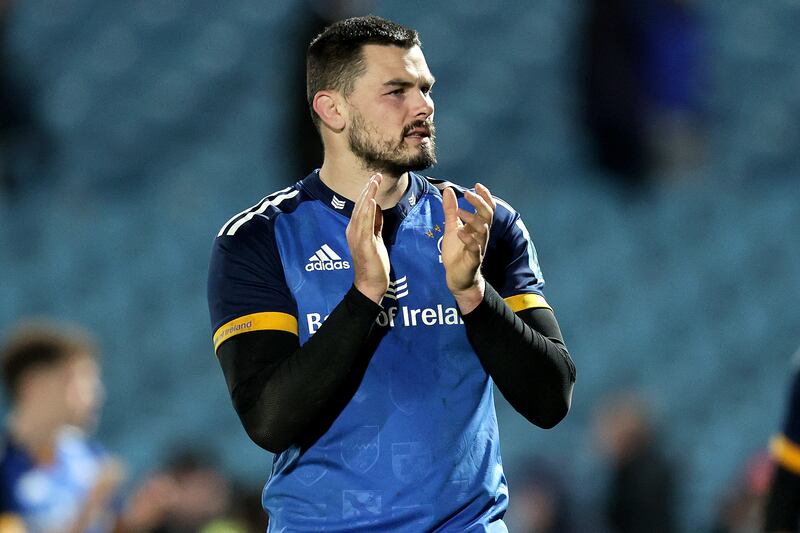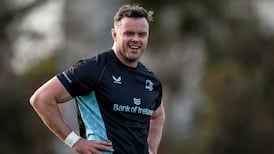Leo Cullen will be at it again this week, looking through his list of senior players. The nine props, the three hookers, the six locks, the eight backrows, the four nines and tens, the four centres, four wingers and three fullbacks.
Calculating the hours and minutes his players have spent on the pitch so far this season and the potential for more pitch time over the next few games is a serious business.
Graham Rowntree will be doing the same with Munster. Both will look at their injury lists, talk to the medics and come up with long term, short term and available to play.
This week the Leinster detail on injury was as follows:
READ MORE
Joe McCarthy – came through the game at the weekend with no issues after an ankle injury.
Rónan Kelleher – was involved in the wider match day squad at the weekend and will be available to train fully this week after a shoulder injury.
Scott Penny has entered the graduated return to play protocols and will be further assessed. Robbie Henshaw is expected to step up his rehabilitation from a minor quad issue this week and will be further assessed.
James Lowe is expected to step up his rehabilitation from a calf injury and will be further assessed. Cian Healy picked up an ankle injury against Cell C Sharks and will be further assessed.
There were no further updates on Vakhtang Abdaladze (neck), Ed Byrne (tricep), Rhys Ruddock (hamstring), Johnny Sexton (groin), Jamie Osborne (knee) and Martin Moloney (knee).
Leinster also announced this week the names of players who would be entering their academy for the 2023-24 season. Andrew Osborne (Naas RFC), Conor O’Tighearnaigh (UCD RFC), Fintan Gunne (Terenure RFC), Gus McCarthy (UCD RFC), Henry McErlean (Terenure RFC), Hugh Cooney (Clontarf FC), Liam Molony (Dublin University FC) and Patrick McCarthy (Dublin University FC) were added as Year One players.
Each week there are streams of names flowing through the head of Cullen. In the churn of bodies for this season’s campaign, he has used 61 players, 45 of them from the senior squad, all but six Irish.
Cullen needs his best team on any given day, while also thinking weeks ahead and factoring in everything including the strength of opposition, importance of the match and considerations such as flying to South Africa for two weeks or players’ preferred positions.
Talking to Max Deegan this week he said: “I like both six and eight. I like the lineout aspect of six, the game management and obviously the ball-carrying of the eight and then the defensive pieces align to both.
“Defensively you’ve a bigger role at six, holding edges and a lot more organisation. In the lineout, you’ve a much bigger role as a six, jumping, attacking and defensively.”

Cullen knows this detail. It is in his head for all the players and it funnels into the rotation equation that will turn out a team against Munster, with a final the following week in mind.
Nor does the IRFU want Leinster to hand over flat and broken players for Andy Farrell to then put them through a World Cup wringer in France.
Yet Cullen needs the best players at his disposal to face Munster and the following week play against La Rochelle in the Champions Cup final. The only certainty is that both groups of players will not be the same.
When Graham Henry took over as coach of the All Blacks he ambitiously said that he wanted to have two or three world-class players in each position. When he brought the squad to the 2007 Rugby World, he had so many options it led to a tournament record. In the All Blacks pool stages, 13 of the 15 starting positions featured three different players.
As Leinster must face replacing Johnny Sexton, so too did the process allow New Zealand to replace perhaps the best outhalf they ever had, Dan Carter.
But Cullen’s task is also fraught with danger. Building combinations and consistency rewards those players who perform week to week. But if changes are not made there’s a danger of allowing the opposition to know what to expect and it fails to give fringe players a chance to play. That knocks their confidence.
Rotation also disabuses players of the notion that they “own” the jersey and keeps complacency at bay.
Cullen’s rotation policy may sometimes hurt consistency – although this season Leinster have been the embodiment of that. The only grit in the ointment was the recent record 62-7 beating by the Bulls at Loftus Versfeld, the first defeat the season.
But the long-term effects of rotating have lasting benefits. It has helped to keep team morale high and allowed the coaches to develop depth across the squad, not just a starting 15 or match day 23 players. That creates competition for places.
Teams sometimes get it wrong and maybe Leinster did last season, coming so close to success but ending in relative misery.
Then again, maybe the most important aspect of rotating players is not about rugby at all. It’s about the entertainment value of a game and the principle of a team resting star players for home matches and denying supporters. You can’t ask fans to pay for steak and then serve them hamburger.
Another ingredient to go in Cullen’s curating this week. Rotating a squad is not all figures. Sometimes it must be a fine art.


















